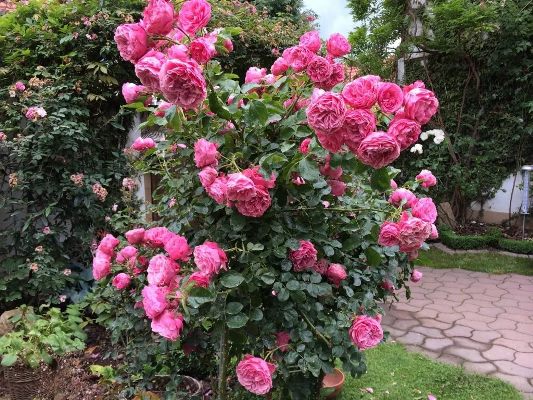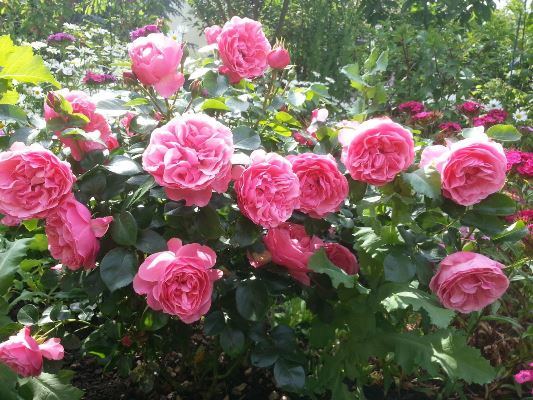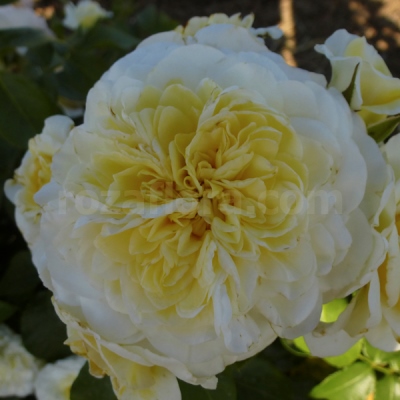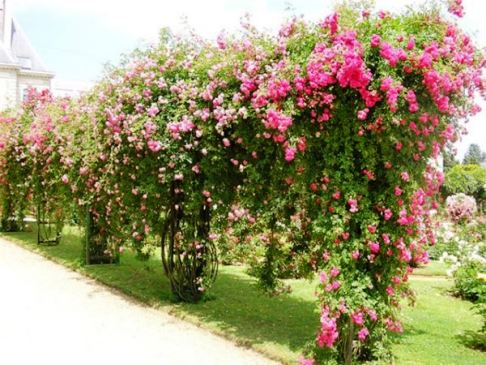What kind of care does the plant need?
Even such a relatively unpretentious variety like Leonardo da Vinci needs regular and proper care:
-
Watering. In the absence of precipitation, the bush is watered weekly, consuming 10-15 liters of warm settled water. After watering, the soil is loosened. The end of flowering means the need to cut the water rate by about half.
-
Top dressing. The rose begins to fertilize from the second season after planting. In the spring (immediately after removing the winter shelter and about 2 weeks before flowering), nitrogen is applied in any form (15–20 g of mineral fertilizers per 10 liters or an infusion of fresh manure diluted with water 1:10). From the moment the buds are formed, the bush is fed every 2 weeks with any complex fertilizer for roses. In the last decade of September, potassium sulfate is introduced (30–40 g per 10 l).
-
Disease prevention. The variety has an unusually good immunity. With proper care, in order to avoid the development of diseases typical of roses, two preventive treatments are enough - in mid-April and about a month after the end of flowering. They use any copper-containing preparations from time-tested copper sulfate and Bordeaux liquid to modern preparations of biological origin (Alirin-B, Previkur, Maxim).
-
Preparing for winter. The frost resistance of the rose is sufficient for Europe, but not for the Russian climate. In preparation for winter, the bush is high (30–40 cm) hilled. A frame of arches for a greenhouse or poles is installed above it, pulling any covering material on it. From the inside, the "hut" can be filled with fallen leaves, straw, finely chopped newspapers. The shelter is opened slightly when the average daily temperature in spring reaches 4–6 ° C, and it is completely removed when the snow has completely melted.
-
Pruning. The basic principle is a combination of light pruning for some shoots that will bloom early, with strong pruning for others, which ensures the formation of new stems and their later flowering. In a planted bush, all shoots are immediately shortened by about half. The next spring, all branches that have not survived the winter are cut out, the remaining ones are shortened to 15–20 cm (3-5 buds). In autumn, non-flowering and non-lignified shoots are cut off completely, those that have bloomed are pinched by 10-15 cm. Then, every spring, sanitary pruning is carried out, all one-year-old shoots are cut by a third, 15-20 cm are left from the oldest, others are pinched by 2-3 kidneys (12-15 cm). In the fall, they do the same as last year.
How to care for a plant
Despite the fact that Princess Anne Rose is not the most whimsical representative of the whole family, she needs care. The optimum temperature at which a plant is active in growth varies from 17 to 25 degrees.
Important! At temperatures above 27 degrees and the location of the rose in an open sunny space, shedding of leaves and buds is possible. Watering frequency also affects the plant.
Park roses need moderate watering as the topsoil dries out. Watering should be done in the first half of the day, but not more often than once a week. Care must be taken to ensure that no water gets on the leaves and buds of the plant. Loosening the soil twice a week is a must to enrich the roots with oxygen. In order for the rose to grow upward, it is necessary to carry out a thorough weeding. To reduce the amount of weeding, you can sprinkle the hole with sawdust.
Watering frequency also affects the plant.Park roses need moderate watering as the topsoil dries out. Watering should be done in the first half of the day, but not more often than once a week. Care must be taken to ensure that no water gets on the leaves and buds of the plant. Loosening the soil twice a week is a must to enrich the roots with oxygen. In order for the rose to grow upward, it is necessary to carry out a thorough weeding. To reduce the amount of weeding, you can sprinkle the hole with sawdust.
Important! For irrigation, you must use water at room temperature. Fertilization of the soil should be carried out twice a season.
It is best to do this in early spring and during the active flowering of the plant. At the end of summer, the feeding process must be completed.
Fertilization of the soil should be carried out twice a season. It is best to do this in early spring and during the active flowering of the plant. At the end of summer, the feeding process must be completed.
It is necessary to cut the plant twice (in autumn and spring) for sanitary purposes and for better flowering during the entire growth of the rose bush.
Important! You need to cut the plant depending on how you would like to see the bush. For the winter, the plant needs to be covered only in that climatic zone where the air temperature drops below 5 degrees
In other regions, you just need to cultivate the soil, carry out a thorough drainage, cut it and leave it until spring
For the winter, the plant needs to be covered only in that climatic zone where the air temperature drops below 5 degrees. In other regions, you just need to cultivate the soil, carry out a thorough drainage, cut it and leave it until spring.
Spray roses

- They were bred in the middle of the 20th century. Their feature is the presence of a large number of buds (more than 15 pieces) at the end of the stem.
- The diameter of the flowering parts reaches 8 cm.The height is about 50 cm.
- For their similar size and shape of the inflorescence, they are sometimes called "pink splashes".
- The decorativeness of these roses allows them to find the widest application: from wedding bouquets to the design of very dense flower beds.
- Planting of plants is carried out in holes up to 40 cm deep, on the bottom of which it is imperative to put drainage in the form of pebbles.
- The rest of the actions are standard for roses: a layer of compost or fertile soil is placed on the drainage, a bush sits down, covered with earth and watered with a large amount (up to 10 liters) of water.
Their advantages include:
- long flowering, beginning of summer and lasting up to 3 months
- variety of colors and shades: from yellow to bright red
- unpretentious cultivation
- frost resistance up to -20 ° С
Caring for them is not difficult. It includes regular loosening and moderate watering. Pruning is done several times during the season: as a rule, this is the beginning of spring, when diseased, dried stems are removed, as well as the end of flowering, in which only wilted buds are cut off. They require shelter for the winter.
Top dressing is standard, applied to all types of spurs: nitrogenous fertilizers in spring, phosphorus-potassium fertilizers in summer; It is best to do summer dressing during the budding period or the beginning of flowering.

TOP 20 plants blooming in July: what should you choose for a garden, vegetable garden or flower bed? | (Photo & Video) + Reviews
How the variety reproduces
The Leonardo da Vinci rose is propagated mainly by cuttings. New specimens bloom in the third year. The generative method does not guarantee the preservation of varietal traits; dividing a bush means replanting it, further exacerbating the stress received by the plant.
A rose stalk is part of a one-year shoot, cut off about 2 weeks after bud formation. Its length is 12-15 cm, 3-4 growth buds are required. The upper cut is made straight, the lower cut obliquely. The leaves are cut by about a third.

Cuttings from rose bushes are cut shortly after flowering.
In order for the cuttings to take root, they act like this:
- For 3-4 hours the lower cut is immersed in a solution of any phytohormone (Epin, Zircon, Heteroauxin).
- Cuttings are planted in fertile loose soil in a greenhouse or in an open bed under a film, providing high (up to 90%) humidity and a temperature of about 25 ° C. You can also root them at home.
- In the fall, those that have given roots are transferred to the basement or cellar, dripping into wet sand or peat.
- In the spring, roses are planted in a permanent place.

Cutting roses is not a particularly difficult, but at the same time giving good results, method of their propagation.
Description of Leonardo da Vinci's rose
The description of the rose of the Leonardo da Vinci variety speaks of it as a medium-sized plant of a bush type. Most often, it grows up to 70-100 cm.Under favorable conditions, it can reach 1.5 m.
Its shoots are erect, strong, up to 1-1.5 cm in diameter. The stems of the current year are flexible and have a green bark with a brown color below. From the second year, the bark coarsens, becomes rough and takes on a gray-green color. The shoots of the Leonardo da Vinci bush rose are covered with rare reddish thorns.
The root system of Leonardo da Vinci's park rose is powerful, with one long taproot and many smaller branches. This is what makes the variety unpretentious to watering and relatively drought-resistant.
Leonardo da Vinci's pink rose, in addition to its beautiful buds, is distinguished by abundant leaf formation. The leaf plates are medium in size and the usual oval shape with a serrated edge and a sharp tip have a leathery structure. The leaves are distinguished by a beautiful dark green color and glossy sheen.

If you believe the photos presented by gardeners, Leonardo da Vinci's rose can grow almost throughout Russia, with the exception of the northern regions. It tolerates bad weather well, expressed in a drop in temperature in summer or heavy rainfall. It reacts somewhat more sharply to windy weather. Nevertheless, its buds do not lose their attractive appearance, and their dense petals do not fall off under the influence of rain or strong winds.
This is not to say that Leonardo's rose is a separate variety. Rather, it is a variety series, currently represented by three varieties. The classic variety has pale pink buds, Red - bright red, White, respectively, white. All their characteristics are identical, only the colors of the buds differ.
Also, the rose of Leonardo da Vinci, judging by the reviews of gardeners, is unpretentious to growing conditions, including the chemical composition of the soil, and does not require much attention when caring for it. The variety is considered optimal for beginner florists, since its cultivation does not require deep knowledge and extensive experience in floriculture.

Group of varieties
Rose Leonardo da Vinci belongs to the floribunda subspecies. This is a hybrid of the polyanty variety "Sommerwind" or "Summer Wind", as well as a subspecies of Tantau, among which there are park species and hybrid tea varieties. From the first, she took the compact size of the bushes, the many flowers and excellent resistance to the vagaries of the weather. From the second - the original color of the petals and erect shoots that do not need support, which distinguishes Leonardo da Vinci's rose from climbing varieties.
Attention!
Many consider Leonardo da Vinci's rose to be polyanthus. This is a wrong opinion
Polyanthus varieties form more inflorescences. However, they are smaller, up to 6 cm in diameter. The size of their leaves also differs.
In varieties belonging to the floribunda subspecies, the leaves are larger. Flowers in both species are really double. The rest of the bushy rose of Leonardo da Vinci looks like a stem or ground cover.
In general, it is similar to the polyanthus, bushy subspecies. Low to medium height, erect shoots, a tendency to active growth, the formation of a large number of double inflorescences and a long flowering period.

Description of the red rose by Leonardo da Vinci Red
The red rose of Leonardo da Vinci differs not only in color, but also in the shape of the inflorescence.They are formed by up to 100 petals of scarlet color, collected in cupped inflorescences. The sepals themselves are more delicate in structure than that of the pink subspecies. The words of the florists and the description of the variety by the breeders are confirmed by the photo of the rose by Leonardo da Vinci Red.

Description of the white rose by Leonardo da Vinci White
The variety forms compact bushes, no more than 80 cm high. Flowers are double, about 6-7 cm in diameter. Sepals have a pronounced cup-shaped shape. If you look closely at the bud, you can clearly see that the cream or light yellow petals collected in the middle form peculiar squares framed by delicate white petals.
We can safely say that, unlike Leonardo da Vinci Red's rose, the white floribunda of this variety plays in several shades.

What is floribunda rose
Translated from English: blooming profusely. Roses grow on a bush, but the inflorescences are collected in a group and this gives many flowers on one shoot.

The flowers are similar to both hybrid tea and polyanthus.
Florinbunda rose bushes grow more than a meter in height and are very spreading. Flowers in this type of roses make up a racemose inflorescence. The color of flowers is very diverse.
A bit of history
Floribunda is a fairly young species of roses. The fact of the initial breeding of the plant is attributed to various specialists in this field, most often the names of Peter Lambert and the Danish breeder Poulsen are mentioned. These scientists crossed polyanthus roses with hybrid tea. It is believed that the first variety of these flowers was born at the beginning of the last century.
The result: a hybrid-polyanthus rose, which from the first took on the shape and size of the flowers, and from the second - resistance to weather conditions and the similarity of inflorescences.

Rose garden
Then these roses were crossed with others (with the same musky ones), which ultimately led to the emergence of a group of rose varieties - Florinbund. The world owes its present-day form of flowers to E. Berner (the famous breeder); on account of which there are more than six dozen varieties bred by him.
Landing
Roses need open ground and soil well enriched with organic matter. Seedlings can be purchased without roots from November to March. Such planting material is much cheaper than container plants.
If dormant bushes are purchased, then after the purchase, the roots are immediately dipped into a bucket of water. Leave in a humid environment for no more than a day, since a longer stay in such conditions can lead to rotting of the root system. If the rose is not planned to be planted right away, then you can simply moisten a cloth with water and wrap the roots in it.
Before planting, the roots are cut a few centimeters. This procedure may seem wild and terrifying, but it is actually good practice. Such actions stimulate the growth of new roots, especially fibrous ones, which absorb nutrients and moisture from the soil. Thick tree roots serve no purpose other than to anchor the plant in the ground.
Floribundas should be planted 45-60 cm apart. Before planting, the land is cultivated, a pit is prepared, manure, garden compost or other organic matter are added to the bottom. It is necessary to make the depression quite wide and deep so that the roots completely enter the hole along with the root collar
This is very important, since the point, which is the junction of the roots and the trunk, should not be outside - it is immersed in the ground by 5 centimeters. If this joint is damaged, the plant dies
If the gardener plans to propagate flowers by cuttings, then the planting material is first planted in small containers, where it must take root. The soil is watered abundantly, but it should not be too wet. Cover the top with a film or glass jar, which allows you to create a greenhouse effect.


